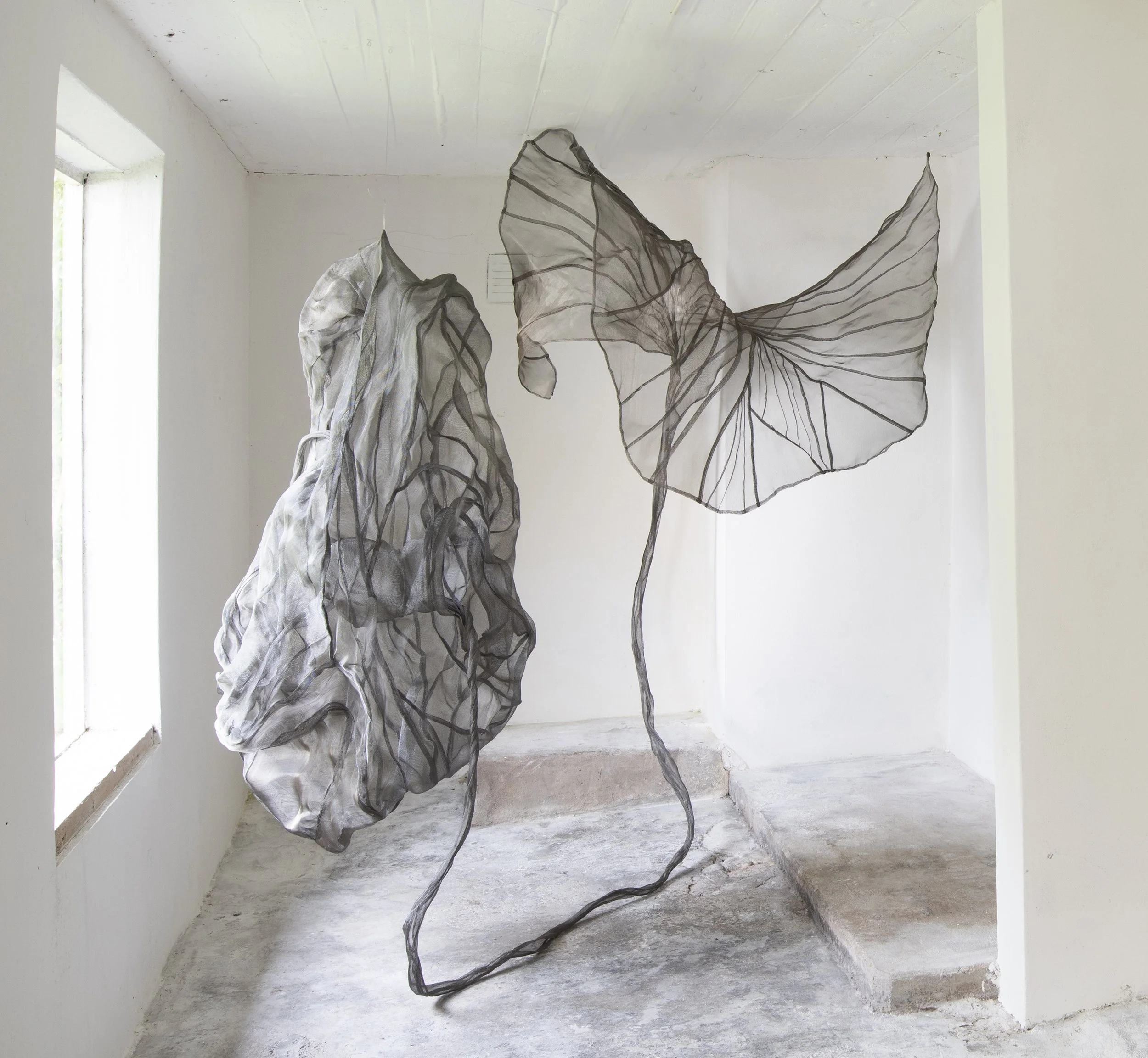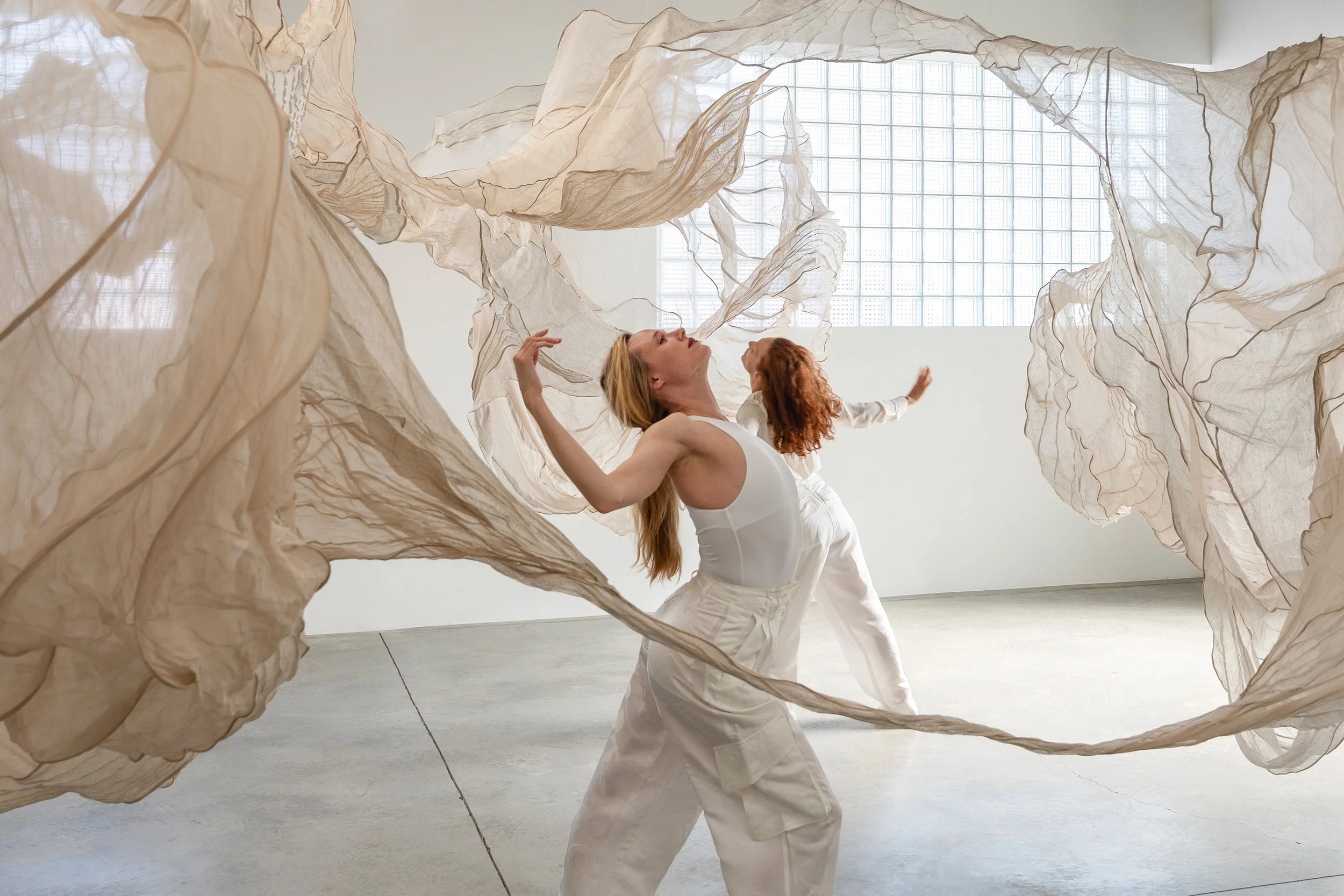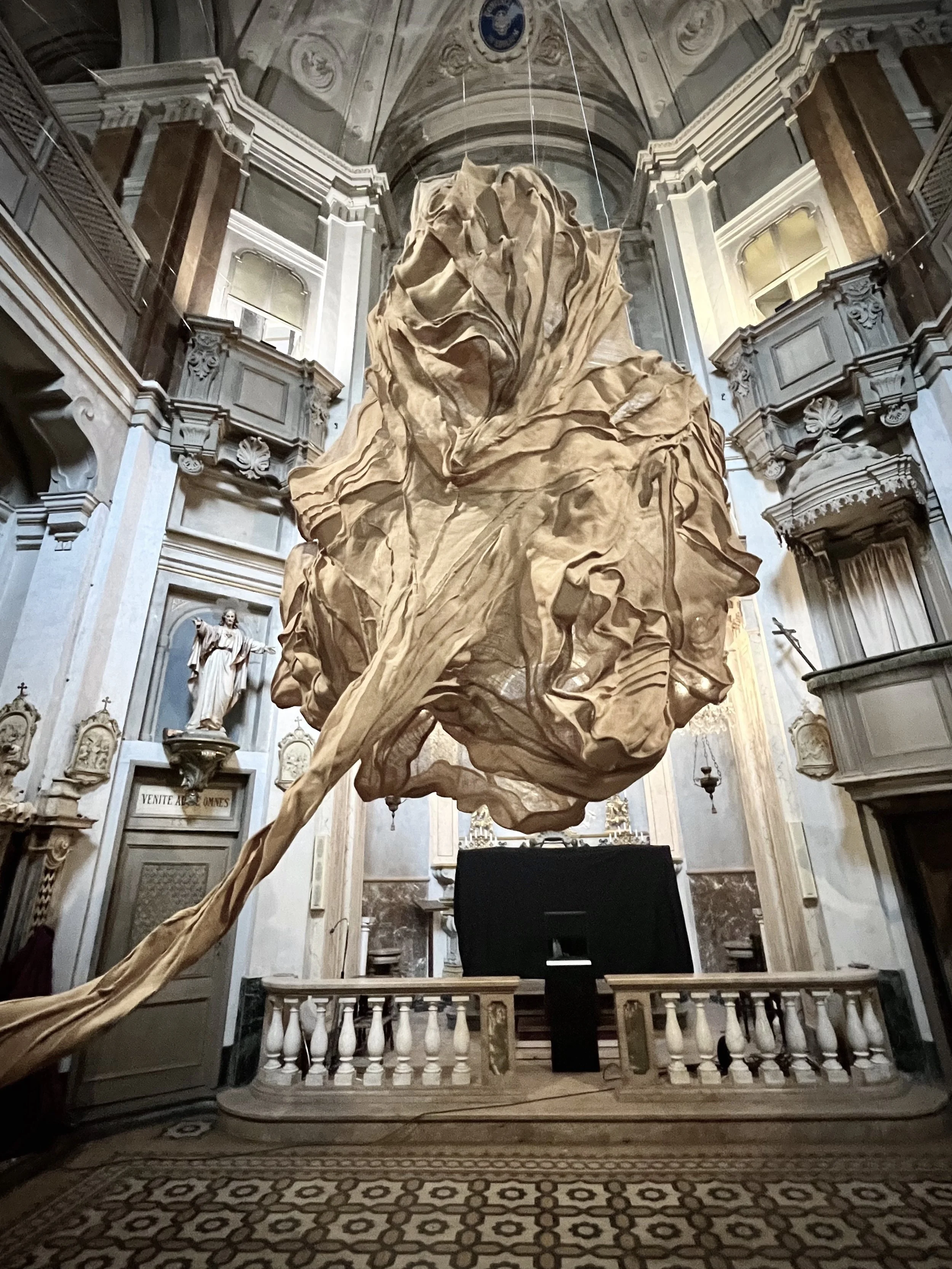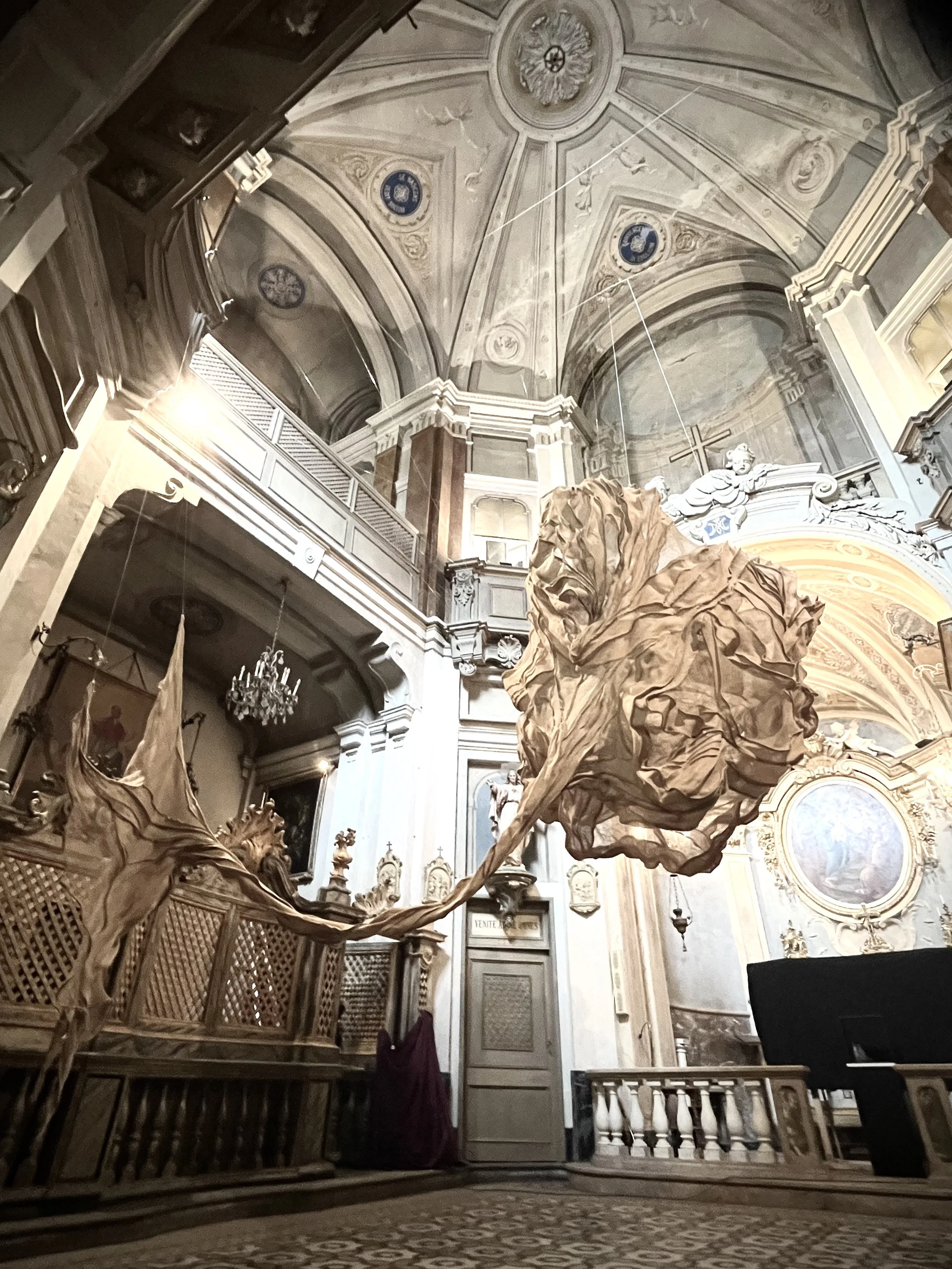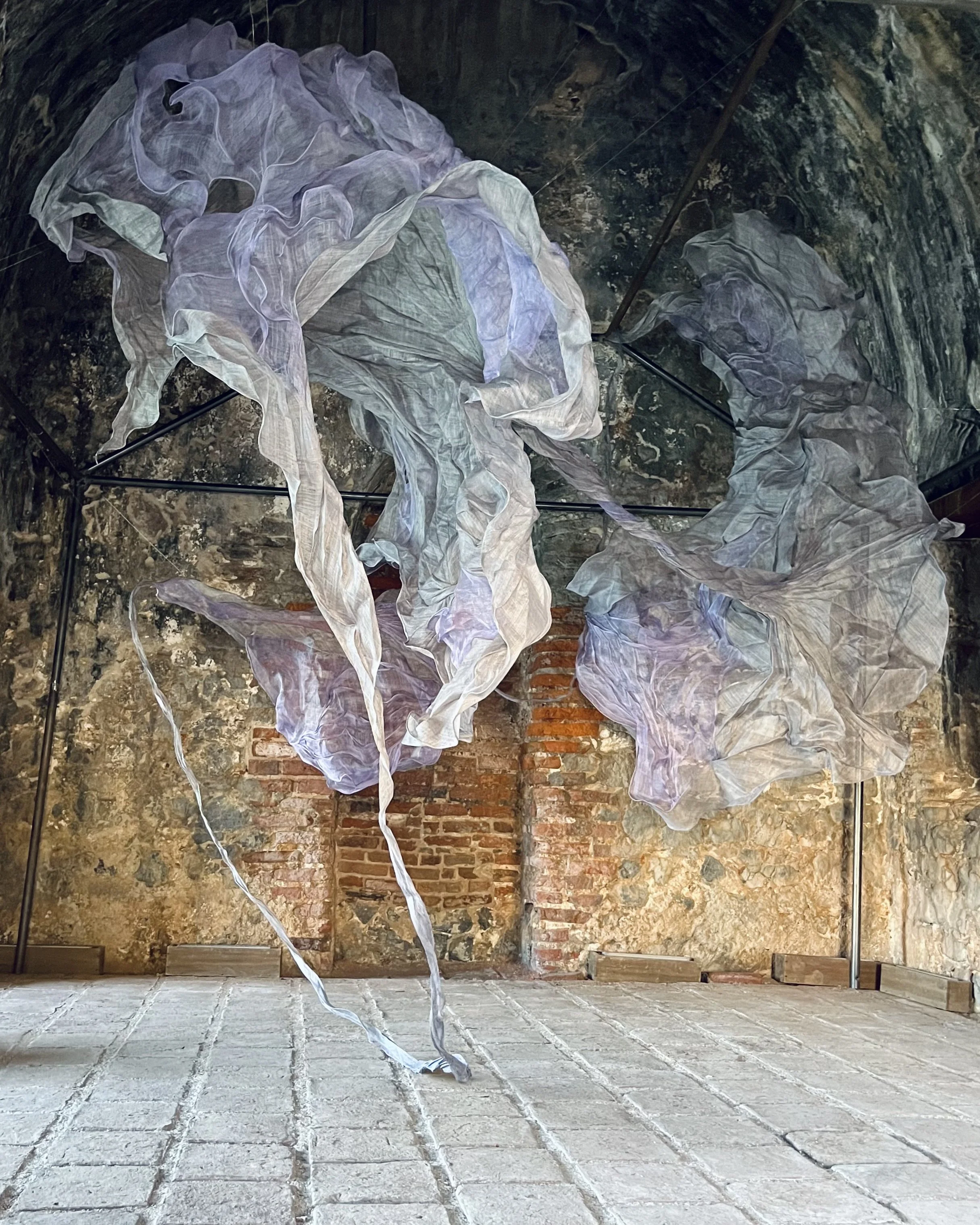Diana Orving
Diana Orving installing Spirit Playground, portrait courtesy of the artist.
Diana Orving is a Swedish artist working primarily with textile sculptures. Her work explores themes of origin, memory, and the subconscious. Her creative process is marked by a dynamic interplay between techniques, materials, and formats—spanning textile sculpture, painting, and costume design. By examining the relationship between the tactile and the visual, and the interaction between body and space, she investigates the intersection of emotion and thought.
Orving approaches her sculptures as living, organic beings with their own will and temperament. The seams in her works flow like elastic, living lines—resembling veins or tree branches. Through a choreographic approach, she explores relationships, conflicts, fears, and longings, emphasizing interconnectedness and the notion that individuals are not isolated, but part of a larger whole. A key aspect of her practice is the dialogue between her sculptures and the spaces they inhabit. Rather than functioning as static objects, her large-scale works create immersive environments that invite viewers to move around or even through them. These installations encourage sensory and spatial engagement, evoking both monumentality and intimacy.
Based in Stockholm, Orving has exhibited internationally at Carvalho Gallery (New York), Tempesta Gallery (Milan), and Singer Laren Museum (The Netherlands), among others. In Sweden, her work has been shown at Galleri Arnstedt, Artipelag, the Gothenburg Museum of Art, the Museum of Textiles in Borås, Varbergs Konsthall, Sven-Harrys Konsthall, Liljevalchs, and Nässjö Konsthall.
LUCIJA ŠUTEJ: Your previous work was tied to the fashion industry and you are a self-taught fashion designer. When did you start your inquiry into the textile’s ability to move beyond the body and actively inhabit and - transform spaces?
DIANA ORVING: My relationship with textiles didn’t begin with fashion. My mother worked with textile art when I was a child—I grew up surrounded by her fabrics, the loom, and the sewing machine. I have vivid memories of her sewing a tent for me and suspending it in our living room. It became a magical space—a place for play. There were also large puppets, tapestries made from found materials, and colorful appliqués.
I started making clothes for myself and my friends in my early teens, which eventually evolved into my label. I began selling to independent designer boutiques and presenting collections. Around the time I was in my early twenties, I began experimenting with textile installations. It felt deeply personal and emotional, something I wasn’t yet ready to show publicly. I think I was afraid of being rejected or criticized, so I kept that side of my practice private while continuing with fashion.
Looking back, I never felt fully happy in the fashion industry. I learned a lot and enjoyed certain aspects, especially the creative process, but the constant demand for new collections was spiritually draining. I longed to work in a more sustainable and expansive way—beyond the body, beyond functionality. Through my art, I feel much more connected to myself.
Diana Orving: Interconnection.
LŠ: Was there also the impact of ballet that prompted this thinking?
DO: I trained in classical ballet and modern dance growing up, and I’ve always been fascinated by the language of choreography. Movement is central to how I approach my art practice. When I install a piece—climbing ladders, lifting materials, watching how they unfold and guide their positioning—it becomes a kind of choreography in space.
I am drawn to organic rhythms: expansion, unfolding and decay. Working with textiles, I aim to give the material a body, a presence and a kind of internal movement. It’s as if I am programming the fabric—guiding it to speak in its language. Everything alive is in motion—slow but relentless. I try to capture that in my sculptures—the sense that they are not still—just momentarily paused. I hope they carry the memory of the hand, the weight of attention, and the pulse of something that continues to evolve.
LŠ:In your work, fabric drapes the body whereas sculpture appears to drape space—how do these two practices inform or reflect one another?
DO: Draping is the foundation of my visual language. It’s an intuitive process, like improvisation—shaping through movement. Whether I am working with the contours of a human body or the parameters of a room, I am trying to create lines and flows that feel effortless. Just as in dance, you have to study and repeat a movement until it feels spontaneous and alive—not forced or unbalanced.
Installation view of Spirit Playground.
Installation view of Spirit Playground.
Spirit Playground Performance.
LŠ: Do you ever consider taking your sculptures outside the gallery walls?
DO: Absolutely. I am very interested in how a piece might shift in response to nature—wind, rain, open skies. I have done some early sketches and material tests for outdoor work, and it is an area I hope to explore further.
LŠ: Your sculptures often feel like they’re in a constant dialogue with—or even at times redefining—the space that they occupy. Has there been a specific piece or installation which fundamentally shifted how you saw the relationship between the work and its surroundings?
DO: In 2022, I gave birth to my second child. After the birth, the midwife showed me the placenta, and I was amazed—it looked like a tree. The umbilical cord was like the trunk, a link between generations, a reminder of how everything and everyone is connected. Just weeks later, I began working on a jute sculpture inspired by this powerful symbol.
The work, Becoming, was first shown at Tempesta Gallery in Milan in 2022. A year later, I installed it in a church (Capella dell'Ospizio di Carità, Giovanni XXIII) in Chieri, Italy. In that sacred space, it gained a new dimension. I was reflecting on the mystery of life, and the sculpture—suspended, resembling a placenta—became almost devotional. A symbol of female life force in a historically patriarchal space, it felt like something sacred had been placed at the heart of the church.
Installation view of Becoming.
Installation view of Becoming.
LŠ: Your sculptures are in a way unpredictable—deeply tied to the unique qualities of their materials, like silk organza. How do you decide which materials to work with?
DO: It’s a very intuitive and sensory process. The choice of material is guided by what the piece needs to express. I work mainly with natural fibers like silk organza, abaca, raffia, and jute because they feel alive. They hold tension, memory, and respond to light and air. I am especially interested in transparency—where the inside and outside of a form are equally important.
Installation view of Lineage.
Installation of Lineage at the studio.
Detail view of Lineage.
LŠ: Do you paint/dye your own textiles? If so - how do you approach the process?
DO: Yes, I dye almost all of my materials by hand. Color is deeply connected to the emotional and symbolic language of each piece. I approach dyeing almost like meditation—it’s a slow, layered, and intuitive process. I use multiple dye baths, shifts in temperature, and natural pigments to achieve specific nuances I’m looking for. I am less interested in “perfect” color and more drawn to shades that feel lived-in, like they hold a memory.
I’ve also been working with sculptural paintings where I apply layers of oil paint onto silk. I think of painting as a process of illumination—where the paint reveals the form, and I guide the viewer’s eye to particular details in the composition.
LŠ: As you mentioned your upbringing was also tied to textiles and your mother also comes from a textile art background). Beyond technique, what philosophies about garments and textiles - has she installed in you?
DO: My mother passed on an instinctual respect for fabric and craftsmanship and also the playfulness that is very present in her work. There was never a sharp divide between art and life in her world; textiles were always present, always in use. That fluidity has shaped my own approach—to treat materials with care and curiosity, and to listen more than control.
LŠ: What is your view on textiles as carriers of collective memory? How does your technique in stitching reflect this?
DO: Textiles are embodied materials—they carry traces of touch, labor, and time. A piece of fabric can hold the imprint of a body, a gesture, a story. Making is my way of processing grief, loss, uncertainty.
Keeping my hands moving—stitching, shaping—gives me a sense of healing. It’s a quiet response to powerlessness.Through those gestures, I embed myself in the material. The work becomes a physical imprint of thought and feeling. In many of my pieces, I work with dense, tight seams. It’s time-consuming, but it transforms the fabric into something resembling a living tissue. The repetition is a form of active meditation, where I focus on my breathing while I sew—stitch by stitch, breath by breath. My time is embedded in the piece.
No two seams are identical; each has its own line. Like veins in a body or branches of a tree. The seams and threads are a kind of language—marking transitions, holding tension, sometimes unraveling.
Exhibition view of Becoming Red.
LŠ: In previous interviews I was captivated by the shared belief of approaching fashion as almost moldable/fluid architecture. What do you think these fields could learn from each other? How do you think they could expand their scope?
DO: Both fashion and architecture shape how we move through the world. Fashion works at the scale of the body, architecture at the scale of the environment—but both involve form, identity, and function.
I think fashion could learn from architecture’s structural thinking, and architecture from fashion’s intimacy and adaptability. If both moved toward softer, more responsive systems—adaptable skins, living structures—we might dress and build in ways that are more human.
Installation view of In Between.
Installation view of Shapeshifters.
LŠ: Are you planning any collaborations with architects?
DO: Yes, I am in conversation with a few architects and designers about future collaborations. I would love to explore architectural-scale installations, especially in public or unconventional spaces. Textile is my primary material, but I’ve recently started researching how to translate my work into other materials—like metal—without losing its sense of movement and intimacy.
LŠ: Do you ever consider expanding your work into the digital realm?
DO: My practice is very analog—it’s essential for me to work with my hands, to feel how the scale relates to my body and to spend time with the work. I often think of my sculptures as organisms or beings—with a life of their own. I help them become what they’re meant to be.
That said, I’m curious about experimenting with projections or kinetic elements to extend the tactile experience into other dimensions. But any digital extension would need to preserve the intimacy, the sense of physical presence—the breath, the gravity, the space around the work.

